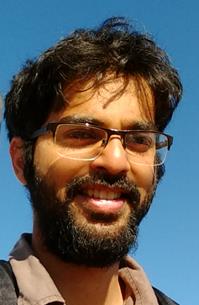Software speeds up design of sustainable irrigation systems
Start-up Heliostrome aims to improve live of vulnerable farming communities
More than a year ago, PhD student Rishabh Ghotge founded Heliostrome, a start-up that develops software for designing solar-powered irrigation systems. This week, Ghotge and his cofounder, Koen van Heuveln, will be in the finals of ClimateLaunchpad, the world’s largest competition for sustainable business ideas. “The technology is of direct benefit to farming communities.”
Ever since the dawn of civilisation, farmers have needed systems for watering their lands so they wouldn’t be dependent on the weather gods. But a large share of farmed land in the global south still depends on seasonal rains for water. The energy transition and new technologies have provided new challenges – and new opportunities. Better design of solar irrigation systems enable crops to receive the right amount of water at the best possible moment with a very low cost and carbon footprint.
Software to bridge domains
“Solar power is one of the cheapest and cleanest form of energy”, Ghotge says. But solar pumping projects require expertise across three separate domains: agriculture, irrigation systems and solar energy. Often, it is a lack of knowledge and data across these domains that makes designing these projects complicated Access to energy is key since in many locations, it is scarcity of energy for pumping rather than scarcity of water that is the biggest challenge for irrigation projects “It takes a lot of time and effort to collect the right data: regarding the groundwater, the crops being grown, their need for water and the amount of solar energy required to pump it.”
Poor designs can cause problems. Pumping up too much groundwater, for instance, is bad for the soil and can have long term effects on the groundwater table. It is also a waste of funds and equipment. “Each project is unique and requires specific design. But the design process can be sped up a lot and that is what we do at Heliostrome: we bridge the gap between these domains and simplify the design process.
Satellite data
The company aims to use satellite data of rainfall, groundwater levels and solar resource to map the local conditions. The end users provide data regarding the size of their farmland and the crops they grow. All these data are input for calculations, based on which Heliostrome determines which pump is suitable, the size of water tanks needed and how many solar panels are required. Farmers are the end-users, but they are not the customers of Heliostrome. “We target the companies that develop and supply the installations. Thanks to our software, they can supply custom-fit irrigation systems much faster and at a lower price.”
The technology is of direct benefit to farming communities, but it also contributes to the energy transition. “Each diesel-powered pump you replace, reduces yearly CO2 emissions by an amount equivalent to 1000 intercontinental flights from Amsterdam to New York.” Improved irrigation also increases crop yields, meaning that, eventually, the amount of farmland can be reduced.
ClimateLaunchpad
Coming from India, Ghotge is now a PhD student working on solar energy at the Mechanical Engineering Faculty, TU Delft. Currently, his company Heliostrome is in the so-called validation phase, in which the business case is critically assessed. Who are the customers and what are the problems they face? Are they prepared to pay for his software? “It is important to think this through carefully, before continuing.” It is why he entered the ClimateLaunchpad competition, of which TU Delft is a partner. Over the past few months, he has received a lot of advice on how to build up a company. “I have learned a lot. The good thing is that our plans seem in order: potential customers are enthusiastic.”
This week, when pitching his ideas in the ClimateLaunchpad finales, will tell if the jury is likeminded. Win or lose, he will continue with his company.
The next step: a working prototype
After completing the validation phase, he will develop a working prototype, a so-called minimum viable product. It will be a case study where the design is carried out with the first version of his software. “It is a showcase for our potential customers and investors.” Hopefully, it will yield sufficient funding for his company to grow.
The current team comprises two people, Ghotge himself and co-founder Koen van Heuveln. There is great synergy. After completing his master’s at the faculty of Technology, Policy & Management, van Heuveln now works at Engie. “He has a lot of experience in both management and business development. People like me, with a technical background, often lack the training in business development and entrepreneurship. Our specialty is in identifying problems, analysing them and coming up with creative solutions.”
Personal drive
At the end of the day, it is the small farmer communities in developing countries about which he cares most. Small and medium farms, comprising less than 10 hectares of farmland. Sustainable energy can help them. “I graduated in solar energy because I believe in the transition from fossil energy to clean energy”, he says. “I want to improve the livelihood of vulnerable communities, those that still heavily depend on monsoon rains. Having access to a stable source of water will greatly impact their quality of life. Solar power offers the opportunity to achieve that in a sustainable way.”

